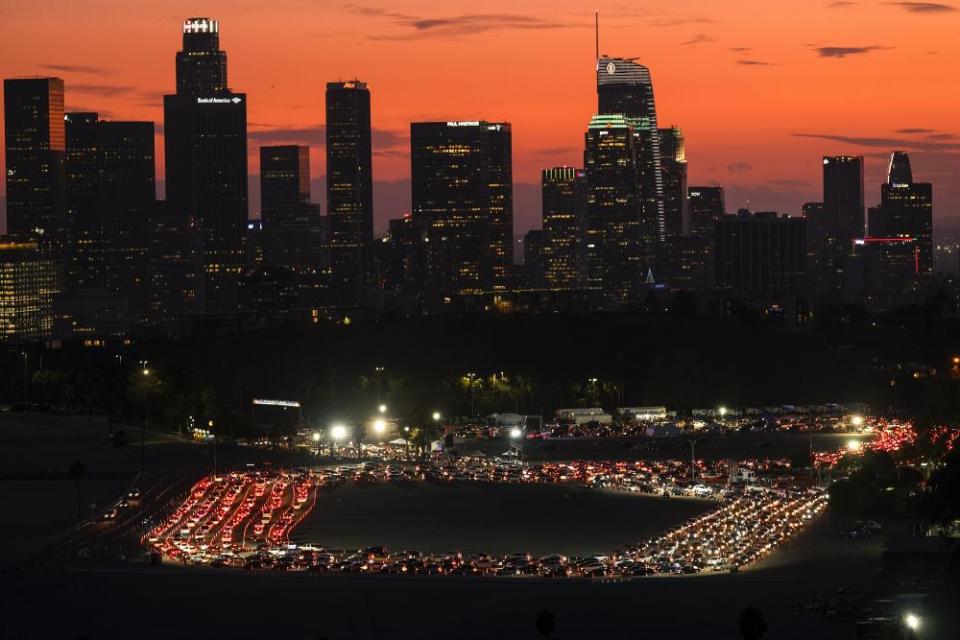California is first state to pass 3m Covid cases

California has become the first state to record more than 3m coronavirus infections, as it grapples with an unprecedented surge of cases that has left hospitals overwhelmed.
That remarkable figure, which comes from Johns Hopkins University, was not entirely unexpected for the nation’s most populous state – but the speed at which it arrived has been stunning.
The first coronavirus case in California, home to 40 million people, was confirmed on 25 January 2020. It took 292 days to get to 1m infections, on 11 November, and then just 44 days to hit 2m, a milestone reached on 24 December. The state hit 3m just weeks later.
Related: 'The horror stories are countless': inside the LA hospital at the center of the Covid crisis
The count is also far ahead of other large states, such as Texas, with more than 2m, and Florida, which has topped 1.5m.
So far more than 33,600 Californians have died due to Covid-19.
Southern and central California have been the hardest hit. In Los Angeles county, the nation’s most populous and the current center of the state’s pandemic, scientists estimate that one in three residents have been infected with Covid-19 at some point since the beginning of the pandemic.
Air quality regulators have recently lifted the limits on the number of cremations that can be performed in Los Angeles county, citing a death rate that is more than double the pre-pandemic norm and an unmanageable backlog of dead bodies.
On average, California has seen about 500 deaths and 40,000 new cases daily for the past two weeks. Although hospitalizations and intensive care unit admissions remained on a slight downward trend, officials have warned that could reverse when the full impact from transmissions during Christmas and New Year’s Eve gatherings is felt.

“As case numbers continue to rise in California, the total number of individuals who will have serious outcomes will also increase,” the state health department said in a statement on Monday.
Adding to concerns, California is experiencing new, possibly more transmissible forms of Covid-19.
The state health department announced on Sunday that a new variant of the virus, dubbed L452R, was increasingly showing up in genetic sequencing of Covid-19 test samples from several counties.
Health officials said it was linked to a Christmastime outbreak at Kaiser Permanente San Jose that infected at least 89 staff members and patients, killing a receptionist. The outbreak has been blamed on an employee who visited the hospital emergency room wearing an air-powered inflatable Christmas tree costume.
The variant is different from another mutation, B117, that was first reported in the United Kingdom and appears to spread much more easily, although it does not appear to make people sicker. The UK variant has also been detected in California.
Meanwhile, California officials are under pressure to expedite the state’s vaccine distribution program, which got off to a worryingly slow start. So far the state has vaccinated fewer than 2,500 people per 100,000 residents, a rate that falls well below the national average, according to federal data.
The state has converted Disneyland, fairgrounds and sports stadiums into mass vaccination sites in an effort to speed things up, as well as opening the first round of vaccines to anyone over the age of 65.
Many of the state’s residents remain under strict lockdown rules, which have closed schools, shut numerous businesses, and limited travel and gatherings. The latest restrictions are tied to hospital ICU capacity, which has rapidly dwindled.
In southern California and the San Joaquin Valley regions, ICU availability is currently 0%. Healthcare workers inside an overwhelmed Los Angeles hospital recently told the Guardian they had been forced to erect triage tents, put beds inside a gift shop, and treat patients in the waiting room in order to accommodate the surge.
“The horror stories are countless,” Dr Jason Prasso, an ICU doctor, told the Guardian.
Meanwhile in the north, more than 50 wine country-based restaurants and wineries have filed a lawsuit against Gavin Newsom, California’s governor, arguing that the state’s restrictions on outdoor dining violate the California constitution’s equal protection clause and due process. They believe that even if they survive the pandemic, their communities will not be able to pull through economically.
“We’re projected to have lost more than $3.5m in gross revenue last year,” Anthony Cognetti, chef and founder of Tre Posti in St Helena, said in a statement. “The latest shutdowns have forced us to lay off 95 valuable staff members, and it’s devastating to consider what this has meant for them and their families. If we make it through the dining ban, we fear there won’t be enough local industry workers left to rebuild our staff.”

 Yahoo Finance
Yahoo Finance 